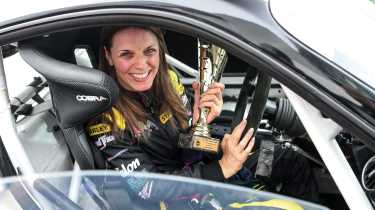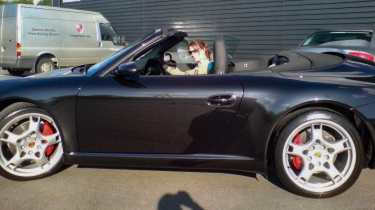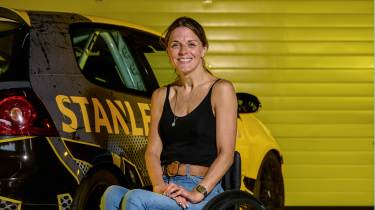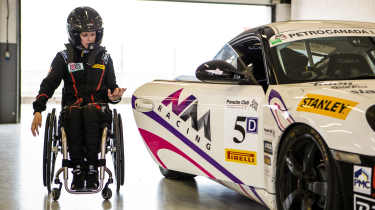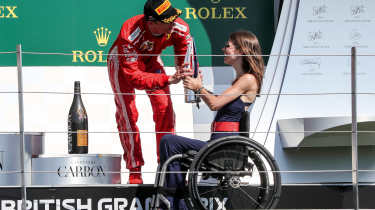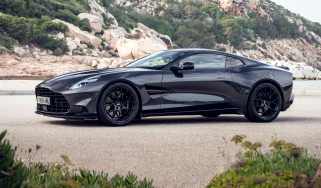How Nathalie McGloin became the world’s only female tetraplegic racing driver
The world’s only female tetraplegic racing driver, McGloin shares her passion for circuit driving via charity trackdays for people with spinal injuries and her FIA position promoting accessibility in motorsport
'I’ve no family history of cars or motorsport,’ says Nathalie McGloin. That hasn’t stopped her creating quite a legacy, though. She’s the world’s only female tetraplegic racing driver, she’s the FIA Disability and Accessibility Commission president, promoting access for all to all aspects of motorsport, and in 2016, with her husband, rally champion Andrew Bayliss, she co-founded Spinal Track, a charity giving track and rally driving experiences to people with spinal injuries.
‘I’ve always been competitive, the firstborn,’ says McGloin. ‘I always had to be top dog. I didn’t use it in a productive way before my injury but definitely have since.’ She was 16 and had just started her A-levels when she had the accident that left her paralysed from the chest down. ‘Growing up in Bridlington, there wasn’t a lot to do,’ she says. ‘So I hung around with an older crowd who were into cars. I didn’t really like the cars, I just liked the danger; I was a bit of a tearaway teenager.
> How crashing a Lotus Cortina turned Paul Ripley into a driving guru
‘The accident was no one’s fault, just wrong place, wrong time. We had a free period at school, so I went to the next village with a friend who’d recently passed his test. On the way back, people were turning into a hidden driveway just as we were coming over the hill. We weren’t speeding, we just lost control as we tried to avoid them and hit a tree, and I broke my neck. I can’t remember the accident although I was fully conscious through it. Sometimes the brain just blocks it out.
‘There was no moment that I can remember that anyone said, “You’re never going to walk again.” I don’t remember that conversation. It was just – excuse the pun – put one foot in front of the other: let’s get out of intensive care, get off the tracheostomy, get to spinal rehab and then go back to school and get my A-levels.
‘I made a promise to myself quite early on that I wouldn’t let my disability stop me from doing what I’d always planned to do. Before my accident I wanted to go to university and, well, that was just not going to not happen.’ She went to Nottingham even though she was barely independent. ‘I couldn’t really get in and out of a car. I didn’t have anyone there helping me. I just decided it was sink or swim. And then I found wheelchair rugby and that was really the making of me. It introduced me to a family of people like me, with my injury, who really showed me how I could get the best out of myself.
‘When I first started driving, cars for me were independence, because I could go anywhere I wanted without help. I also loved the fact that, when I was in a car, no one could see my wheelchair.’ McGloin’s first car was an adapted Peugeot 206, later supplemented by a Saab 9‑5 estate to carry her special rugby wheelchair. Then along came a Mini. ‘The Mini was the first car that I kind of got noticed in, and I liked the attention. I progressed to a 911 – a 997 Cabriolet Tiptronic – and that ignited something. I was 22 in a 911. No one expected to see a wheelchair come out the door when I parked up. I loved the noise and the speed but it was more the fact that it disguised that I was disabled, which is a very different perspective because I’m proud of being disabled now. If I wasn’t disabled, I wouldn’t be doing any of the things that I am doing because my life, post breaking my neck, took me on a path.’
Circuit driving came along almost by chance. A rugby friend told McGloin he’d ordered a new M3 and that it was faster than her 911. She didn’t believe him so he invited her to a trackday to settle it. ‘I was instantly addicted to the speed, but the fact I could do it at the same time and in the same way as able-bodied people was a freedom. People were interested in the controls of my car. I hadn’t had that before. I was there as an equal, I fitted into an able-bodied world – something I hadn’t experienced before.’
Rugby was pretty much McGloin’s full-time job, but she slotted in as many trackdays as she could. Then in 2013 she decided to see if she could get a race licence, ‘maybe just to hang on the wall with my university degree’. Within weeks she’d bought a 987 Cayman S and was turning it into a race car… At the time, disabled people had to do four hill climb or sprint events to validate their licence and she entered her first sprint in 2014 in both cars she owned: an Audi A4 Avant diesel and a 997 Turbo. ‘Not really a fitting car for a novice!’ she laughs. ‘I won my class in the Turbo and they said, “You’ve won first in class, fastest novice and fastest woman, but you’re only allowed one trophy. Which one do you want?” I was like, is that even a question? I won first in class, why wouldn’t I want that?’
She qualified for her licence in 2015 and entered the Porsche Club Championship with the Cayman in Class 1. It nearly all went wrong the first time out testing at Brands Hatch: ‘I lifted partway through Paddock Hill, drifted out into the gravel and the car went on two wheels. I don’t know how it didn’t go over.’ She qualified second from last, in front of a 944 on treaded tyres. ‘I thought, I’m going to finish last in my first ever race; people are gonna think I’m not good enough and I don’t belong. I just wanted to go home. But when the lights went out it was different. I finished 14th out of 21 drivers.’
The next round, Silverstone, was wet. McGloin had scared herself when the back end of the Turbo had stepped out on a trackday, but when the same happened in the Cayman at Copse, it was different. ‘I got a huge snap of oversteer, caught it and I was like: that was really natural. From then on, rain was something that I loved.
‘I’ve never driven a car with my feet, so the hand controls are very natural for me. I drive with my left hand on the wheel. I have my steering lightened in the Cayman so I don’t use any grip on the wheel, I just hold on to it. My left hand isn’t fully functional but it’s got enough to do what it needs on the wheel. And then I’ve got my right hand on the accelerator and the brake, which is a simultaneous lever: you push down to accelerate and push forward to brake, so you can effectively left-foot brake. Normal hand controls are push-pull – pull backwards to accelerate and push forwards to brake – but there’s a big gap between both things, so when going from accelerate to brake the car’s doing nothing for a period of time, which would not be useful in a mid-engined Cayman…’
McGloin’s inaugural season was about to sour somewhat, though. At Snetterton, race suspension was finally fitted to the Cayman and she qualified at the back of Class 1, ahead of the Class 2 drivers fighting for the championship. ‘Then something happened that completely destroyed my confidence. A couple of them came up to me and said, pretty much, “Don’t get in our way.” I locked myself in my car and cried. It was my worst fear realised: they don’t think I belong here; they don’t think I’m any good. The race was awful. I got hit by one of the other drivers, because he couldn’t get past. I just wanted to pack it in, and I carried that through to the rest of the season and into the next season a little bit.
‘I spoke to my husband about it afterwards but I’d never spoken about it publicly until I spoke at an International Women’s Day event last year. Someone in the audience asked me how I would have felt if a woman had said that. I said I didn’t know but I think it would have really pissed me off, and it would have riled me up, like, I’ll show you! But because it was a man it just destroyed my confidence. And I’m not someone who’s intimidated by men and I actually love an argument, but it just reinforced my own fears, my own insecurities. So it wasn’t ideal. And then I had a big crash on the first test day of 2017, at Paddock Hill: ABS failure, so I hit the wall at about 70 and that destroyed my confidence for the whole of 2017.’
McGloin switched to the CSCC (Classic Sports Car Club) series and things picked up. In November of 2017 she got her first podium, a third in class. ‘I then got a second in class the following year, and then I won my first race. So I went from “I could never do this again, I need to hang up my race gloves because I don’t enjoy this,” to getting a race win.’
Simultaneously, something equally special and rewarding had come out of her racing. ‘When I started I got a lot of messages from fellow spinal injuries disabled people, saying, “I didn’t know that we could do this. Can I have a go in your race car?”’ McGloin and her husband had bought a full track-spec Golf GTI from another paraplegic who was a trackday enthusiast, and in 2016 they decided to use it to start a trackday charity called Spinal Track. They ran it out of their own pocket, with free trackdays from Silverstone, but it got to the stage where they couldn’t continue to fund it. And then Stanley Black & Decker got in touch and sponsored Spinal Track and McGloin’s racing. Just before Covid they started a rally programme as well. ‘Bill Gwynne and his guys built us two GT86s with funding from the Richard Burns Foundation. Unfortunately, Bill passed away before we got the programme running, which I still get really upset about because he never saw me in a car. He became like family to us.
‘We have 100 disabled people through the programmes every year, at ten trackdays and ten rally days. We’ve met some incredible people, people that will be friends for life. We had one guy – I always cry when I tell this story – who was injured at a similar age to me. He’d done all of the road driving courses, so a proper enthusiast, and his dad was on the pit wall at Silverstone and Andrew was standing with him. He saw his son driving down and started crying. He said to Andrew, “I never thought I’d see my son do anything like this.” It’s moments like that when we realise what we do. It’s far more than just the driving. It’s freedom and it’s parity and we love it. We don’t take any money out of it, we do it for reactions like that; that’s our payment.’
In 2017, McGloin was offered the role of Disability and Accessibility Commission president of the FIA, which led to her presenting the third-place trophy at the British GP in 2018. ‘I was hoping it would be Kimi or Max,’ she says. ‘I saw Kimi in the paddock, went over and said, “Hi Kimi. I’m Disability and Accessibility Commission president and I’m presenting the third-place trophy after the race.” I felt he kind of looked at me like some crazy woman in a wheelchair but he posed for a photo with me.
‘On the Sunday I was really nervous. It was a huge crowd. When they announced third place, the guy gave me the trophy and I went round the corner to the podium. Kimi saw me and his face completely lit up. He jumped down and he said, “Oh, you said you’d be here.” And I said, “Yes, I wasn’t lying!” He was fantastic. He could see that my hands didn’t work properly and used both of his hands to shake mine and helped me give the trophy to him. He made it so special for me because I felt his reaction was genuine. It was the best day of my motorsport life. Kimi, “Ice Man”, was the warmest person ever and absolutely made the day for me.
‘I’m still the only female tetraplegic racing driver in the world. There is a female tetraplegic who recently started hill climbing in Turkey and plans to go rallying next. She messaged and asked for some advice. Hopefully, she saw what I was doing and thought, “Well, I can do it too.” So that’s pretty cool.’
Ambitions for the future? ‘I’d like to do a 24-hour race. I’d hate it because I hate sleep deprivation but I think it would be something amazing, really challenging. I’m not talking about Le Mans – that’s for professionals. I’d want to do it somewhere warm, so maybe the Dubai 24 Hours.’
Spinal Track is looking for sponsors. Message Nathalie at nathalie@nathaliemcgloin.com
This story was first featured in evo issue 326.

